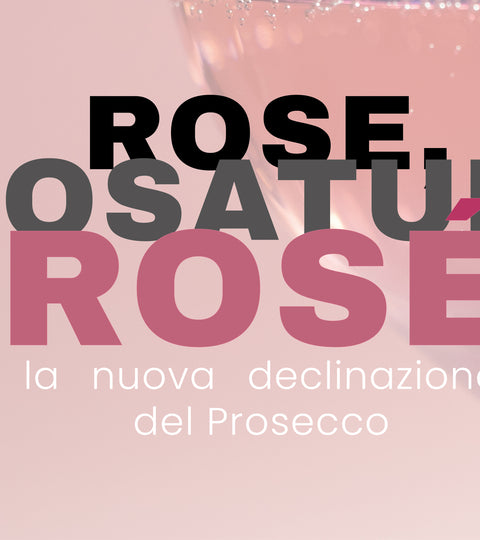Rose, rosatum, rosé: the new declination of Prosecco
From flower to color: the origin of pink
Before 31 July 2020 it was just a wish of many producers and wine lovers but, with the entry into force of the regulations relating to its production, it has become reality. It appeared on the shelves and was talked about like the best stars: Prosecco Rosé DOC was on everyone's lips even before it was bottled.
For a few months it has been enriching the list of jewels in our cellar and, although it shares the same DNA with its brother vinified in white, it has a character all its own which is expressed through its renewed aromas and flavors and its new variations in pairings.
Prosecco Rosé is a fresh novelty. The rosé version of our beloved sparkling wine is the expression of a world always in turmoil, the world of wine, which does not rest on its certainties but experiments and pushes itself, with new colours, towards new interpretations of tradition .
The history of rosé itself is an example of this evolution. In fact, the concept of rosé already existed in Roman times: the recipe for a wine called rosatum appears in a 1st century AD cookbook. At the time, this term did not qualify the color of the wine, but described the characteristic aroma given by the addition of rose petals and honey to the vinous liquid.
Over the centuries the memory of this drink has been lost, so much so that today's word 'rosé' does not evoke the flower, but rather describes the visual attribute of the wine, its being pink. However, in order not to fall into trivializations, it should be remembered that, as happens with any red or white, the color is the result of precise winemaking processes and production choices . Here, if in the eyes all rosés have the same peculiarity, in the cellar not all rosés blossom in the same way: a rosé can be born from different winemaking methods.
But what are the possible vinification methods for a rosé wine today?
A. the blend , or blend, between a red wine and a white wine
The rosé wines produced according to this method are usually bubbles such as Champagne, the Classic Method and, from 31 July 2020, our Prosecco Doc. To make these wines, a red and a white wine are combined in well-defined percentages .
The rosé wines produced according to this method are usually bubbles such as Champagne, the Classic Method and, from 31 July 2020, our Prosecco Doc. To make these wines, a red and a white wine are combined in well-defined percentages .
B. rosé vinification of red grapes
The products resulting from these processes do not require any assembly, but derive aromas and rosy colors from the direct processing of the red berry beans. In this case there are two paths that can be taken, one similar to white winemaking, the other to red winemaking:
- The pressing. It is a modern method that involves applying slow and gradual pressure on the grapes. The wines thus obtained are very fresh and light, with a pale and delicate colour.
- A short maceration : after pressing the grapes and the juice are kept in contact so that the former give color and structure to the liquid. The temporal variable in this case is what distinguishes rosé from red.
How new accents are born: the birth of rosé
As we mentioned, sparkling wines fall into that category of rosés which are obtained through the blend of a white wine and a red wine. The original vines of the two wines, in the case of Prosecco Rosé, have names and surnames: His Majesty Glera and Pinot Noir , which according to the new specification are the only ones that can be used. The first will be used to produce Prosecco, which will make up 85% to 90% of the final product, the second will be vinified in red and will make up 10-15%.
We can therefore say that up until the moment of blending, vinification proceeds along two parallel lines which intersect only at the moment of second fermentation. In fact, the two wines meet in the autoclave and join forces, according to the established percentages, to give life to the bubbles. Here they blend , mutually exchanging colors and aromas and, in the months of refermentation, the birth of the bubbles seals their definitive union: now they are in all respects a balanced and elegant Prosecco Rosé.
Rosé is born from a rib of our Prosecco to be the same and different, to be a wine with fragrant accents, a renewed wine, ready to experiment with new combinations. The story of Prosecco rosé is a story of gentle but decisive encounters and exchanges. Every quality of the basic products is maintained and expanded so that techniques and knowledge are added in the glasses resulting in an elegant explosion of tastes and aromas. Inside the Prosecco Rosé there is everything: a red wine, a white wine, two processes, a blend. Each grape brings with it its heritage and each vinification adds its meanings.
The purpose of these brief theoretical notes is to convey the complexity of the world of rosés, a world that often finds itself unfairly trivialized. We are sure they will be useful for you to appreciate the uniqueness of Prosecco Rosé, understand its background and consciously appreciate its tasting . In this regard, we remind you that you can take action and taste our rosé by clicking here , and ordering a bottle: a toast for academic purposes :)
Cheers
L.
L.

